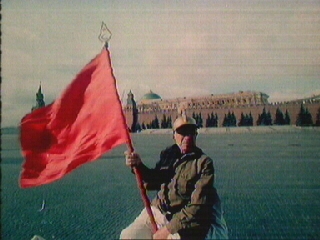Up to the Neck or Bodybuilding
 Communism has not passed easily from Russia. Despite the implosion of the Soviet Union five years before this film was made, her cities are punctuated by the graphic reminders of the collapsed regime. Massive bronze archetypes still stand as a reminder of an authoritarian past. This film offers a personal insight into the life of the former sportsman who became the model for Stalin's tyrannical vision - a living reminder of the true art of authority.
Communism has not passed easily from Russia. Despite the implosion of the Soviet Union five years before this film was made, her cities are punctuated by the graphic reminders of the collapsed regime. Massive bronze archetypes still stand as a reminder of an authoritarian past. This film offers a personal insight into the life of the former sportsman who became the model for Stalin's tyrannical vision - a living reminder of the true art of authority.
Stripped and drawn by an artist, Igor Stepnovisch at eighty now looks like any other frail old man. Yet, when he became the model for so many Soviet statues it was because of the unreality he represented - the conceit of a healthy, happy communist state. In 1933, when he first modelled, Russia was reeling from a five-year economic plan that had left large proportions of the population suffering in extreme poverty. With the pressing need to deny such a truth, Igor became the ideal body for Stalin's ideal lie.
The coming of Communism, and of Uncle Joe, had supposedly destroyed the mythology and mythologizing of the Tsarist regime. But an all- encompassing cult of leadership was to be the hallmark of Stalin's reign. Thousands of statues were commissioned in the conformist style of the time, equating the Communist leadership with the folk heroes of Russia's past. Igor was immortalised in numerous monuments that reflected both Stalin's total power and the absolute nature of his deceit. 'Whether I actually liked him or not did not come into it'.
Nothing could matter more than the great Soviet lie. Art was a stagnant, controlled commodity that nonetheless made many rich. Fallacy can be seen in every stage of the highly constructed, elaborately staged procedures that Igor was the standard model for. His image gave birth to the mass of aesthetically indistinguishable statues produced by a paranoid state. 'What is an artist's model, what does he do anyway?' asks Igor now - 'A phoney' is the only answer.
FULL SYNOPSIS
